|
As
we just talked about and as the Lecture Outline says, the
3 types of LIPIDS are
triglycerides
phospholipids and cholesterol A. Triglycerides (in fats & oils) are the MAJOR type of lipid in food and in humans. Although you may think of eggs as having cholesterol, which they do, the MAJOR type of lipid in an egg is still triglycerides.
|
|
Now watch the Video Clip
below. It will help you draw triglycerides and fatty acids.
Video
Clip: Triglyceridesapproximately 5 minutes |
| If an
approximately 5-minute movie isn't showing up
just above on
your
computer, you may
not have the latest version of QuickTime on your computer. Click here
to download the newest version of Quick Time. As mentioned in the Video Clip, there were a few mistakes in how fatty acids were drawn. |
| Look at the "silent movie" Video Clip below. Like the Charlie Chaplin movie classics, there is no sound, but please don't expect Charlie Chaplin-type entertainment. |
|
"Silent Movie"
Video Clip: Foods approximately 3 minutes If this movie isn't showing
up
just below on
your
computer, you may
not have the latest version of QuickTime on your computer. Click here
to download the newest version of Quick Time.
|
As you're watching the "Silent Movie", you can use the page in the packet (Food Sources of Carbohydrates, Lipids, Proteins.... the LIPIDS part) and also the chart below: | |
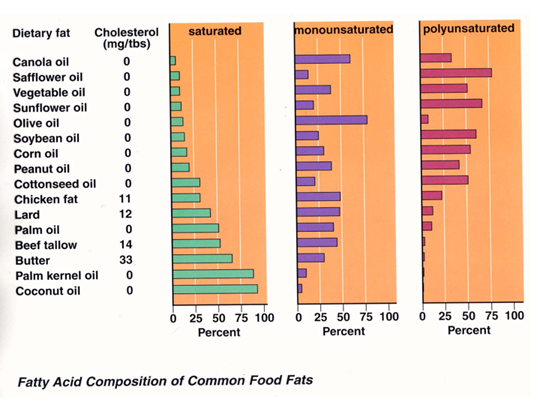 |
||
| The particular baby formula
shown in this "Silent Movie" Video
Clip has two fatty acids added to it to try to be more like
breast milk. These fatty acids are DHA and ARA
(also abbreviated AA). Later in this lecture, you'll find our a
little more about DHA and ARA. |
"The label below is the COCONUT "OIL" shown in the "Silent
Movie" Video Clip above. It's contains many saturated
fatty acids and it's very solid at room temperature.
 Coconut "Oil" |
|
You still have some incomplete parts of
the first part of page 73 in your packet, so let me repeat a little and
fill in a little.
Lipids are very complicated and still not well understood. Your questions will help me as I continue to try to clarify them for myself as well as for you. A. Triglycerides (in fats & oils) are the MAJOR type of lipid in food and in humans. Although you may think of eggs as having cholesterol, which they do, the MAJOR type of lipid in an egg is still triglycerides.
|
The two essential fatty acids
are linoleic acid and linolenic acid.
Below is linoleic acid, which is an
omega-6 fatty
acid. Linoleic acid Linoleic acid (above) is more common in the seeds of plants. The first double bond is after the 6th carbon starting on the left. Below is another way of representing linoleic acid:  Below is the other essential fatty acid, linolenic acid, which is an omega-3 fatty acid.  |
The fatty acids represented
below are not
considered essential
because we can make them from the essential
ones. But having good levels of them in your diet appears to
decrease the risk of heart disease.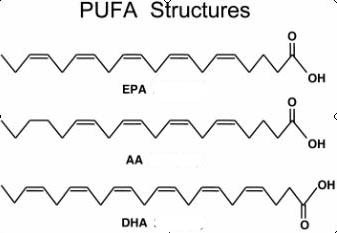 |
| By no means is it important
to know the names of all of the fatty acids in the following table.
This table was made to illustrate a little about the wide
diversity of
fatty acids in foods. All of these fatty acids can do both good things and bad things for our health, so it's good to have neither too much nor too little of them in our diet and to have a balance of them. Butyrate (also known in slightly as butyric acid) is the major energy source for colonic epithelial cells and plays an essential role in the maturation of colonic epithelium, regeneration of mucosa, induction of epithelial cell differentiation, and stimulation of their apoptosis.40 A reduced level of luminal SCFAs may play a role in the onset of IBD. As discussed earlier, fatty acids vary by: 1. Chain length (#
Carbon atoms ) and
2. Degree of Saturation (# Double Bonds) The chart below shows these differences in both chain length and degree of saturation. Chemical
Names
and Descriptions of some Common Fatty Acids
|
|
COMMON
NAME (scientific name is different)
* essential
fatty acids
|
# Carbon atoms | # Double Bonds | Food Sources (Most
of these are oils because
that's what many of the charts I found had. But the cells of all
parts of a plant or animal make fatty acids, even the cells of what we
think of as a low-fat food, like spinach.)
|
A Few Roles & Benefits |
| Butyric acid | 4 |
0 |
butterfat | major energy source for colon
epithelial cells and
plays an essential role in colonic health |
| Caproic Acid | 6 |
0 |
butterfat | |
| Caprylic Acid | 8 |
0 |
coconut oil | |
| Capric Acid | 10 |
0 |
coconut oil | |
| Lauric Acid | 12 |
0 |
coconut oil | |
| Myristic Acid | 14 |
0 |
palm kernel oil | |
| Palmitic Acid | 16 |
0 |
palm oil | |
| Palmitoleic Acid | 16 |
1 |
animal fats, macademia nuts |
|
| Stearic Acid | 18 |
0 |
animal fats | |
| Oleic Acid | 18 |
1 |
olive oil, almonds, peanuts,
avocados |
|
| Vaccenic Acid | 18 |
1 |
butterfat | |
| *Linoleic Acid |
18 |
2 |
many vegetable oils like corn
oil, sunflower oil & safflower oil; almonds, walnuts, peanuts |
involved in rigidity of cell walls, clotting and the inflammation response |
| Conjugated linoleic acid (CLA) |
in the meat and dairy products
of ruminants (Conjugated linoleic acid is a trans fat, though some
researchers claim that it is not harmful in the same fashion as other
trans fatty acids, but rather is beneficial. The trans fat is not
counted as trans fat on food labels.) |
|||
| *Alpha-Linolenic Acid
(ALA) an omega-3 FA |
18 |
3 |
flaxseed oil (linseed), walnuts,
green
leaves |
plants- assoc. with photosynthesis; animals- neurological development and processing, the permeability of cell walls, the metabolism of glucose and the calming of inflammation |
| Gamma-Linolenic Acid (GLA) | 18 |
3 |
borage oil | |
| Arachidic Acid | 20 |
0 |
peanut
oil, fish oil |
|
| Gadoleic Acid | 20 |
1 |
fish oil | |
| Arachidonic Acid (ARA or AA) | 20 |
4 |
liver fats | |
| Eicosapentaenoic Acid (EPA) | 20 |
5 |
cold water fish like salmon |
cells release it from their
membranes to communicate with each other |
| Behenic Acid | 22 |
0 |
rapeseed (canola) oil | |
| Erucic Acid | 22 |
1 |
rapeseed (canola) oil | |
| Docosahexaenoic Acid (DHA) | 22 |
6 |
fish oil | animals make from ALA to think
& see |
| Lignoceric Acid | 24 |
0 |
small amounts in most fats |
Your Lecture Outline on page
73 lists linoleic and linolenic as
the essential fatty acids. It goes on to give other examples of
omega-3 fatty acids such as EPA and DHA. Then thee are a few
blanks:
(these are also _ _
FAs). What do you think goes there?
Hydrogenated Fatty Acids - In an attempt to find an inexpensive substitute for butter, as far back as 1903, Britain was adding hydrogen gas to liquid (polyunsaturated) oils in a process called hydrogenation. This hydrogen reacted with the double bonds in the structure of the unsaturated fatty acids of the corn oil. Most of the double bonds were now filled (saturated) with hydrogen. Not only did this make the oil solid at room temperature (so margarine and shortening were possible from oils like corn oil), it also preserved them by making the oil more stable and less likely to go rancid (so baked goods like cookies and chips would have a longer shelf life). Rancidity is when oxygen attacks double bonds. 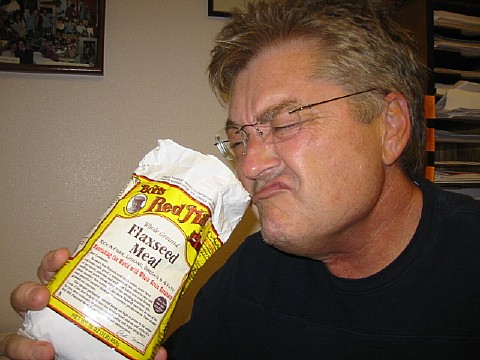 So why is the above flaxseed meal especially prone to rancidity, leading to a distasteful smell for my colleague Roger Hecht? The
above chart shows that one of the fatty acids in flax seed has 3 double
bonds. As said above, rancidity is when oxygen attacks
double bonds. With more double bonds, more rancidity
happens.
Flaxseed meal is a wonderful
food but it should be refrigerated to keep it from going rancid.
When concerns arose in about the 1970s and 1980s about the saturated fats in the palm and coconut oils used in baked goods and margarine (in part because they were cheaper than butter) they were often replaced with these hydrogenated fats made from oils from corn and soybeans. When used in cookies or potato chips instead using an oil like corn oil that contains polyunsaturated fats, the product had a longer shelf life. And products like margarine made with corn oil were solid similar to butter. McDonald's and Kentucky Fried Chicken found the hydrogenated fats gave a wonderful crispness to their French fries and chicken that was difficult to replace. Jif liked the smooth “mouth feel” small amounts of it added to their peanut butter. |
Trans Fatty Acids -
Hydrogenation of polyunsaturated fatty acids saturates with hydrogen
most of the double bonds but it does leave some of the double
bonds.
These partially hydrogenated and artificial fatty acids now have an
unusual shape that has an effect in the body similar to saturated
ones.
In about the 1990s, evidence began accumulating that trans fat are not healthy, “Numerous studies have found that trans fats raise our risk of heart disease," says Cynthia Payne, a registered dietitian at the University of Maryland Medical Center. "They can also contribute to an increase in total cholesterol levels and a drop in the healthy HDL cholesterol. These man-made fats are much worse for you than any other natural fat, even the saturated fats found in butter and beef.” Substitutes for trans fats- In 2006, the U.S. government began requiring trans fat information on the Nutrition Facts of food labels. This has prompted the food industry to mostly eliminate, as far as I can tell, the use of hydrogenated fat. What they are sometimes using instead are the same palm oil and coconut oil (both of which contain saturated) that they removed from their products in the 1980s. In a later chapter, we'll look at how genetic engineering is providing the food industry with a substitute soybean oil that has no trans fat. Although those soybeans have been engineered to have less of the fatty acid that needs to be hydrogenated, the beneficial omega-3 fatty acids in soybean oil are no longer present. |
| Video
Clip for the Lecture Outline about Hydrogenation plus B. Phospholipids C. Sterols approximately 7 minutes This will help you fill in other parts of page 73 in the packet. |
| Now that you have an
understanding of fatty acids, I hope you can see why the food industry
has been interested in finding ways to use inexpensive fats, like
soybean oil, but to saturate them so they would be less likely to go
rancid. |
An interesting fact about phospholipids is that they make up about 25% of the dry weight of the brain. Many of the fatty acids that are part of phospholipids in the brain are omega-3 fatty acids they can "preserve or enhance brain function". ("A Systemic Review of the Roles
of n-3 Fatty Acids in
Health & Disease,
ND Riediger et al, Journal of the American Dietetic Association, April 2009, p. 671) As the Lecture Outline says, plants make sterols, but not cholesterol. An article in the journal Nutrition Today about pistachios said "Among tree nuts, pistachios
are the richest source of phytosterols, particularly beta-sitosterol
and campesterol."
"Phytosterols are plant
sterols, which compete with cholesterol in the intestinal lumen for
uptake into the bloodstream, and phytosterols may reduce cholesterol
levels."
"The Pistachio: A Surprising
and Colorful Nut"
David Hever, MD, PhD Susan Bowerman MS, RD Nutrition Today Jan/Feb 2008 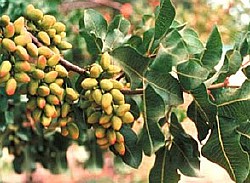 The
article said that pistachios are botanically related to cashews and
mangoes (!).
Although they are native to the high deserts of West Africa and the Middle East, our neighbor California now grows them. |
| So
which fat is best to eat? In my opinion, the best way to get fatty acids is in WHOLE foods, as you're also getting a variety of vitamins, minerals, phytochemicals and sometimes fiber and protein. And consuming a lot of refined fats, whether it be in butter, olive oil or margarine can lead to an excess of a particular fatty acid that can be detrimental to health. There are definitely times, though, when we may prefer something that is not whole, like when we have a nice slice of toast or we're wanting to stir-fry vegetables. For bread and toast, what I prefer is butter, and the first reason for that is a personal preference for the taste of butter. Just a little bit goes a long way and I don't think a little bit of butter is going to raise my risk of heart disease, especially when there are also plenty of fruits, vegetables and whole grains in what I eat. A second reason I like it is that I can easily buy butter that comes from Oregon farmers. For sautéing and other uses, I like to use a variety of fats and oils. One time we'll buy corn oil, the next time canola oil and the next time soybean oil. For salads and other uses, olive oil is great and we always have it on hand. There is a growing California olive industry so we can even buy it more regionally produced. We also keep some sesame oil on hand. As this lecture has discussed, different oils have different fatty acids, and we're continuing to learn the benefits of individual fatty acids. When I was on a study leave in Indonesia in 1990, I visited Akad Gizi (Academy of Nutrition) in Jakarta and talked to the researcher below who was investigating the effect of palm oil on the cholesterol level in rats. I don't know what he found out, but a March, 2006, Chefs Collaborative Communiqué: A Slippery Slope: The search for sustainable fats and oils said that with new research, coconut oil is understood to be a very good source of medium-chain fatty acids (known as MCT- medium-chain triglycerides), "which aren't stored as readily in the body as oils composed of long-chain triglycerides (LCT)". 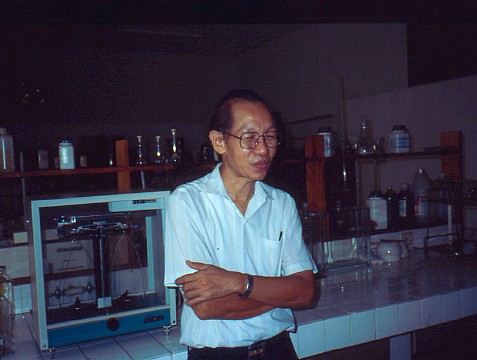 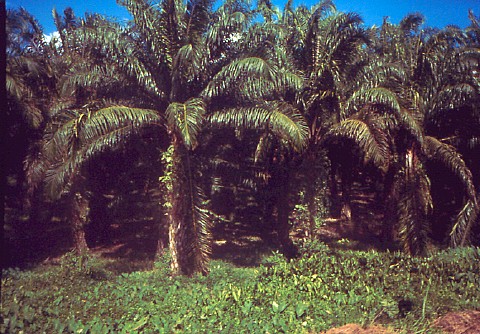 The above photo and the one
below are at an is oil-palm plantation we visited on Malaysia.
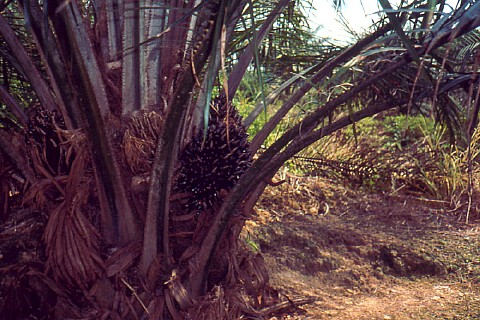 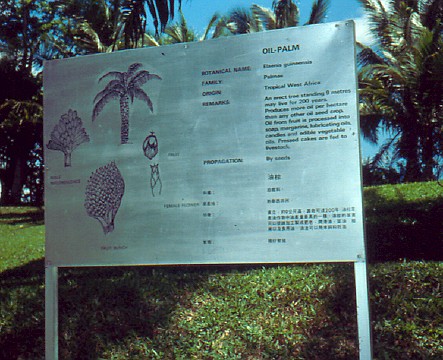 This sign was at the Singapore Zoo. Wikipedia has more information: http://en.wikipedia.org/wiki/Oil_palm Here's putting it another way: We continually search for an inexpensive and healthy fat, frequently changing course. The food industry wants one that has a long shelf life and won't go rancid easily. |
| mid 1800s | Demand for a less expensive replacement for butter. Oleomargarine made from beef. |
| 1911 | Proctor & Gamble Company introduces Crisco brand shortening made from partially hydrogenated oils. Under the influence of temperature, pressure, and catalysts, hydrogen gas is added to oil. |
| mid 1950s | Palm oil & coconut oil used in baked goods & margarine as less inexpensive, stable and solid. |
| 1980s | Health
authorities conclude that the saturated fats in products like lard and
palm oil increase risk of LDL-cholesterol leading to increased risk of
heart disease. Groups like the Center for Science in the Public Interest (CSPI) pressure the food industry to switch from palm & coconut oil to partially hydrogenated vegetable oils. |
| 1990s | Research emerges indicating
that the trans-fatty acids (TFA) formed during hydrogenation raise
LDL-cholesterol. CSPI reverses its earlier supportive position and lobbies FDA to regulate TFAs. |
| about 2005 | Products were reformulated with oil blends including
palm oil. Research with "interestification" of stearic acid in a manufacturing process to synthesize fats with a high melting point useful for frying. It leads to positioning changes of FA on the glycerol backbone of the TG, changing the fat's digestion, absorption and health effects. Notice in the chart above in this lecture called Chemical Names and Descriptions of some Common Fatty Acids, stearic acid is a long chain fatty acid that is saturated. Through conventional plant breeding and genetic engineering, oilseeds are being bred to produce oils that are just as stable, solid and low in TFAs (more later). The fatty acid composition has been changed to “low-linolenic” and “high-oleic”. (Note from instructor: This decreases the content of beneficial omega-3 fatty acids, which both decreases the likelihood of it going rancid but also decrease possible health benefits.) Kris-Etherton PM, Grieal AE,
Psota TL, Gebauer SK, Zhang J, Etherton TD. Dietary stearic acid and
risk of cardiovascular disease: intake, sources, digestion, and
absorption. Lipids.
2005;40:1193-1200.
|
| On page 47 of your packet,
I give my definition of' WHOLE foods
PARTITIONED foods REFINED foods I am considering adding a fourth category called SYNTHESIZED foods. These would be foods created in a laboratory using chemical reactions. Examples would be the hydrogenated fats and interesterified fats described above. Another example of a SYNTHESIZED food would be high fructose corn syrup, which was first developed in 1957 and it's made by enzymatic processing of corn syrup. To me it seems like a waste of money to try to create something artificially when we'd be better off to limit fried foods and use small amounts of butter. (I've said before that I have a bias here as I love the taste of butter and I'm not tempted to overeat it.) Also, it's large corporations like Archer Daniels Midlands who can afford to do the research and develop these products. They may feel a more critical commitment to profits for their executives and current shareholders rather than our long-term health. |
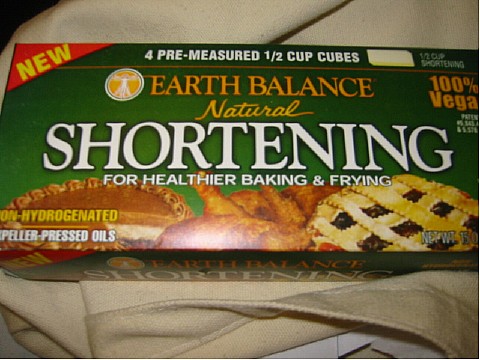 |
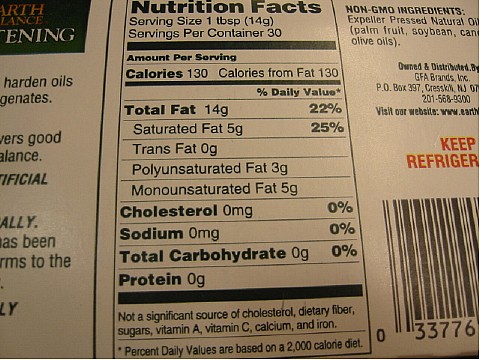 Since margarine
companies want to advertise their product as having no hydrogenated fat
and no trans fat, they have been using other ways of making their
margarine solid and spreadable. As mentioned earlier, what some
companies are choosing
to use are things like palm "oil" (oil- palm trees are picture above),
which is high in saturated fat. See the INGREDIENTS
lists pictured above and below.
"Imports of palm oil from Malaysia to the United States have increased by 50,000 tons in the first 6 months of 2006 as compared with the same time in 2005." ("Reducing the Trans-Fatty Acid Content in Foods:
Regulatory and Food Industry Approaches"; Peter A. Graf, Shawna Lemke
and Maureen DiRienzo; Nutrition Today,
March/April 2008.)
|
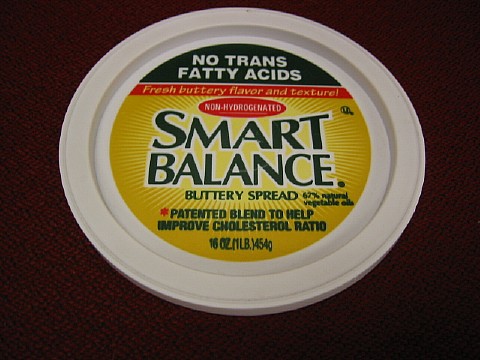 |
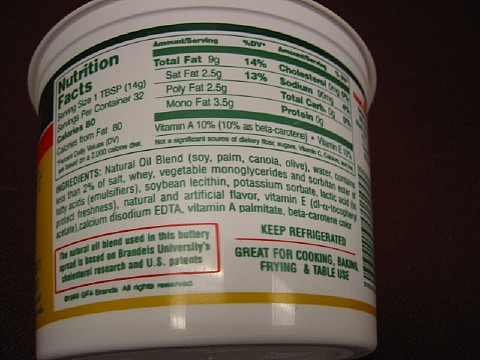 Count the number of ingredients in this spread. |
| I'm just reading Michael Pollan's new book called "In
Defense of
Food", a wonderful read. He has a whole section on margarine and
other
imitation foods. As I've said before, my opinion is that butter is a better choice than any margarine but it's difficult to convincingly make that point when what Pollan calls the "nutritional industrial complex" has such a strong interest in persuading us otherwise. There is a lot of profit in the food industry being able to constantly re-engineer ingredients to respond to the latest fad. In my opinion as well as Pollan's, all margarines are fake foods and they are most likely nutritionally inferior to a natural food. Pollan says "adulteration has been repositioned as food science." These lectures have often said that WHOLE foods are usually the best way to get nutrients. Just look at the nutrients in pistachios, listed in the previously mentioned article. 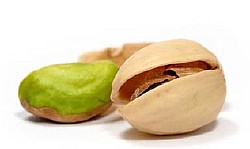
Using the "MAGIC DV", which nutrients would a serving of these pistachios be a good source of? Our local filberts are just as nutrient dense as these pistachios are. |